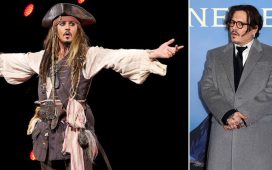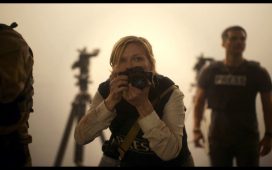This is dedicated to “those wonderful people out there in the dark.” My first movie reference — it won’t be the last here — refers to the words spoken by silent-screen star Norma Desmond in Sunset Blvd. to describe audiences. You know us: this happy breed willing to wait on long lines, pay inflated ticket prices, and crowd next to each other at the multiplex to share the experience of watching a movie on the big screen. (The bigger the better — right, IMAX?) How quickly the COVID-19 pandemic has squashed the fun we once took for granted. There’s no telling how long the coronavirus will continue to drive us into isolation, especially since our lives now depend on social distancing. But safety can’t erase the pain of losing the communal charge that we get as faithful filmgoers.
Having tested positive for cinema obsession practically since birth, and after spending more than three decades reviewing movies for Rolling Stone, I feel the ache of lockdown as I walk past shuttered multiplexes, staring at posters for Black Widow, Tenet, The French Dispatch, and other summer movies we won’t be seeing any time soon. Sure, I can stream movies on my laptop (never a smartphone!) or dip into my collection of more than 20,000 movies — mostly Blu-rays, but I still have a few on laser disc and even VHS. And I revel in them and those behind-the-scenes extras on a 70-inch home-theater monitor with a state-of-the-art sound system.
But here’s the truth, and the truth hurts: The couch-potato version of filmgoing is just not the same. Damn Sartre for saying “hell is other people.” For movie lovers, other people are heaven. Nothing beats a theater with an audience, even if you don’t know everybody (or anybody) sitting near you.
OK, so the experience isn’t always ideal. Martin Scorsese once said that he’d long ago stopped going out to the movies because audiences are “talking, eating, checking cellphones, getting up every five minutes and coming back with more food.” In his 1991 remake of Cape Fear, the filmmaker stuck it to Max Cady, the psychopath played by Robert De Niro, by showing him at a Florida movie theater, sitting spread-eagled in front of Nick Nolte and his family while blowing cigar smoke, laughing maniacally and drowning out the dialogue on screen. Scorsese’s point is well taken. But occasional bad manners are a small price to pay for the giddy jolt you feel when you and the audience are riding the same wave.
Raised in Yonkers, New York, only 45 minutes by bus and subway from first-run theaters on Broadway, I always relished the event aspect of going to the movies. My mother says she felt her first contractions with me at a movie house, the same place (RKO Proctors) where she and my dad later took me to see Disney movies. Parents never learn — I didn’t with my kids — that Disney movies, from Bambi to Onward, inexplicably like killing off mommy and daddy with impunity. However, once you recover from that trauma, you’re hooked for life. And, oh, the thrill when you’re old enough to tag along for, say, Planet of the Apes, when audiences lost their minds at the climactic sight of the Statue of Liberty, askew on the shore.
It’s not hard to recall those moments when you and the audience reacted and roared as one. How about that scene in Jaws when the shark first heaves out of the water and Roy Scheider tells salty dog Robert Shaw, “You’re gonna need a bigger boat.” Or the blood-pumping exhilaration you felt at the first Star Wars when Han Solo (Harrison Ford) climbed into the Millennium Falcon with Chewie and blasted off to galaxies far, far away.
For those born before the home-video revolution, seeing movies in theaters was the only game in town. It never felt right watching these movies on TV, edited, censored, and littered with commercials. If your movie love took on a religious fervor when the names of film directors became as familiar as the actors, your curiosity led to an even deeper dive into Hollywood’s past. Today, we can access cinema’s golden oldies with a link to a streaming service (kind of). Back then, we needed revival houses. There was a treasure trove in New York, with the Thalia, the Art, the Theatre 80 St. Marks, the Quad, the Film Forum, and the grindhouses on 42nd Street before Disney sanitized the reek and once-alluring danger of the Forty-Deuce.
The audience shared my education by watching Hitchcock’s Psycho like it should be watched — in the dark, where the shower scene never loses its nerve-rattling power. You could go deeper into Hitchcock with Vertigo, about Scottie (James Stewart), a San Francisco detective tracking a beautiful blonde (Kim Novak) who may be a figment of his own twisted imagination. Vertigo is the essence of what movies are about: being swallowed up and zapped home to a place you’d never been before. Hitchcock, abetted by Robert Burks’ serpentine camerawork and Bernard Herrmann’s peerlessly seductive score, puts Scottie and the audience in a trance. Looking around, I could see my fellow viewers eagerly trying to puzzle out Hitchcock’s most haunting masterpiece. Vertigo is a personal favorite for many reasons, but mostly because it had the nerve to leave me hanging and searching for answers.
Where would I get those answers? Not from those friends who thought “it’s OK” or “it sucked” qualified as analysis. The internet? What internet? No one had a personal computer in those days. But at film school at New York University, I could chew things out with professors and students and those reviewers who made you feel they were sharing your experience. It killed me that my go-to film critic, Pauline Kael, thought Vertigo was junk. What?!
So I wrote down my feelings and started on my own path to film criticism. Then as now, it felt like you were with me.
You were there when revival houses provided my intro to global cinema (Truffaut, Fellini, Kurosawa, Godard, and Bergman, yes — but also Wertmuller, Denis, Akerman, and Varda). Flickering projection couldn’t kill our joy at diving into classic works by Hitchcock, Welles, Ford, Hawks, Kubrick, Parks, and Cassavetes. We were eager to soak up the past while hurtling into first-run movie houses to catch the new Scorsese or Spielberg or Eastwood or Altman or Lynch or Coppola or Demme or Cronenberg (or Woody Allen and Roman Polanski, not yet stymied by personal controversies).
And when I lucked out with a lifetime job as a professional critic, you were in on discovering Paul Thomas Anderson, Wes Anderson, Quentin Tarantino, Spike Lee, the Coen brothers, Kathryn Bigelow, Steven Soderbergh, Todd Haynes, David Fincher, Jordan Peele, Richard Linklater, Greta Gerwig, Taika Waititi, Bong Joon Ho. The names go on. How about that trio of Oscar-winning amigos — Alfonso Cuarón, Guillermo del Toro, and Alejandro G. Iñárritu — and those uncensored and uncut gems of the new indie armada, Josh and Benny Safdie.
The only constant in all this diversity is you, the audience. And no way did we, or do we, always nod in polite agreement. What a kick battling over the polarizing likes of Fight Club, Mulholland Drive, Drive, Under the Skin, and Joker, or sticking it to sacred cows like Out of Africa, JFK, Crash (the Oscar-winning one, not the Cronenberg one), and Life Is Beautiful. But the arguments, the give-and-take, the challenges are the essence of why we go to the movies.
“The audience is its own kind of beast,” the late, great Robert Altman once said. Standing with the wickedly acerbic director behind the last row at a public screening of Short Cuts, I asked him what he was getting from staring at the backs of people’s heads. “Audiences are the way I take the temperature of a room and find out if my movie is working,” he confided. “It’s not the laugh, cry, or scream bullshit. It’s how they sit in their seats and stay focused. Or don’t. It’s not a science. But it’s there. You can feel it.”
We all know what Altman means. It’s a “collective effervescence” — a phrase coined a century ago by French sociologist Emilie Durkheim — that makes us feel that we’re all in it together. In 1995’s Get Shorty, John Travolta plays Chili Palmer, a loan shark and movie junkie who hits a revival house to take another look at his favorite film noir, Orson Welles’ 1958 Touch of Evil. Saying the dialogue to himself in sync with the actors, Chili is a man in his element. “Wow, huh?” he says to the strangers surrounding him in the theater as the lights go up. Those true believers know what he’s talking about. So do you, if you’re being honest. We need each other, movies and audiences. COVID-19 has shut down our relationship, but God and science permitting, it won’t be for long. We’ll be there when the smoke clears, as committed and connected as ever out there in the dark.















